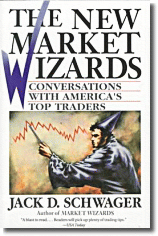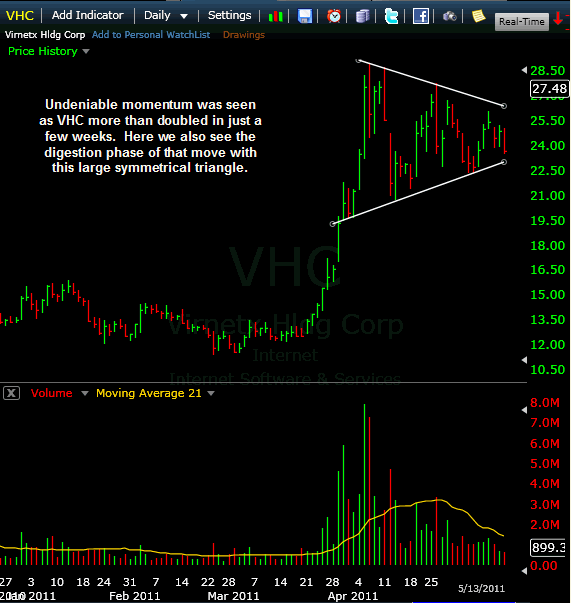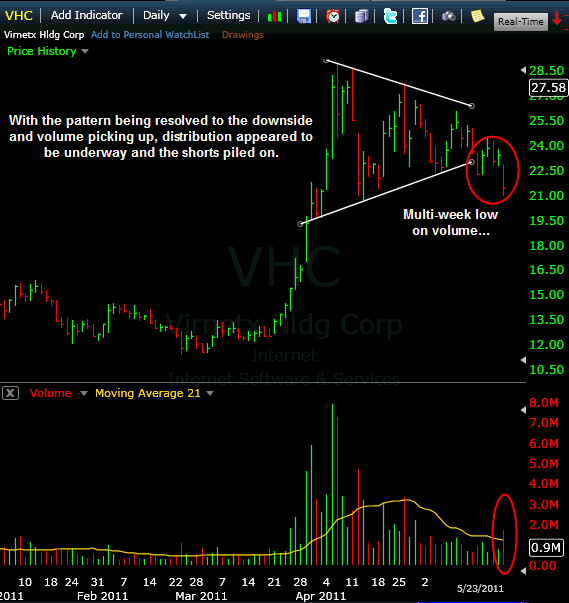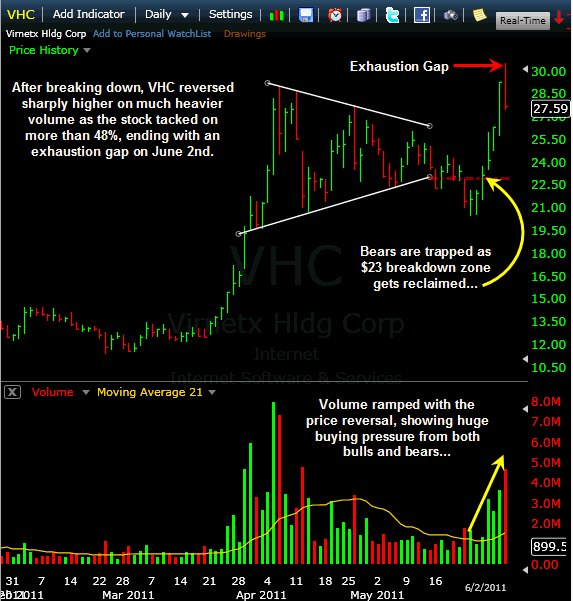 Archive for June, 2011
Archive for June, 2011
Lighten and Tighten
June 6, 2011 at 11:38 am
An absolute commitment is required for some things in life, like let’s say, a social function. Either you’re going or you aren’t, right? However, other things might require a lower level of commitment. Your diet, for example, might currently be more of an “I’m trying not to eat too many sweets” approach right now. That’s what I’d call a partial commitment, where it’s not an all-or-nothing approach.
 When it comes to trading though, far too many traders think they have to be “all in” or “all out” of their positions. Nonsense! Think outside the box a little.
When it comes to trading though, far too many traders think they have to be “all in” or “all out” of their positions. Nonsense! Think outside the box a little.
On the surface, we know that commissions are so cheap these days that there is no problem with splitting up positions by making partial exits when a situation calls for it, so that shouldn’t hold you back from adopting this mindset.
There are some occasions when it’s very useful for me to either lighten my position size, tighten my stop, or both. Let’s look at some examples of each, and I hope you’ll add your own thoughts to these in the comments below.
Lighten!
* I should clarify that I’m talking here about lightening up on a position mid-trade. This is not to be confused with when to trade smaller.
Lightening up on a position is a way to Defend both my capital and my profits. Whenever I get a poor fill on a trade where my order is executed at a price which is considerably different than my trading plan accounted for, it’s time to lighten up. By definition, the risk/reward profile of the trade has changed (since the entry price has changed and my stop is now farther away), so naturally I need to make an adjustment. This is the scale I use to do that on my swing trades. Doing this keeps my risk in check with what it should be, allowing me to stick with the trade – even if it’s now a smaller amount.
Tighten!
I won’t enter a trade unless I know my get-out (stop loss), but that doesn’t mean my stop never changes. Sometimes the situation changes in such a way that an adjustment is warranted.
 Market conditions may necessitate such an alteration to my plan. Suppose I’m long as a limo, and suddenly the complexion of the market shifts to something quite negative. Maybe news breaks or we see a key reversal set in – well, I’m in denial if I think the landscape hasn’t changed. In those cases, it makes sense to tighten my stops on long positions as a way to shore up my risk.
Market conditions may necessitate such an alteration to my plan. Suppose I’m long as a limo, and suddenly the complexion of the market shifts to something quite negative. Maybe news breaks or we see a key reversal set in – well, I’m in denial if I think the landscape hasn’t changed. In those cases, it makes sense to tighten my stops on long positions as a way to shore up my risk.
On a per-trade basis though, sometimes the way a stock moves just happens to change, and that can also warrant tightening my stop. Maybe a stock initially breaks out with momentum, but rather than showing follow through or putting in healthy rest, it simply begins to stagnate. Volume disappears, a sloppy trading range sets in, and I start to see a lack of conviction with weak closes in the stock for several straight days. That’s a time when I’ll definitely tighten up my stop, whether in time or price, as the stock simply isn’t behaving in such a way to deserve a long leash.
Both!
My favorite occasions are those which allow me to both lighten my position and tighten my stop. That usually occurs when my first profit target is hit. That’s a spot where the trade has moved enough to warrant booking some gains (lighten), but the stock may not be done running yet. Typically, I’ll have 2 targets, so sometimes there’s still room for additional gains.
At this point, my initial stop is also now a considerable distance away, so it makes sense to tighten it as well (often to breakeven for remaining shares). This way, I’m risking less on what’s left of my position, while still allowing for additional profits if the stock continues to run. Win/win.
** What are some keys you use mid-trade for knowing when to lighten up on your size or tighten your stop? I have a Bandit t-shirt for the best response, so bring the ideas!
Trade Like a Bandit!
Jeff White
Producer of The Bandit Broadcast
Timeline of a Short Squeeze
June 3, 2011 at 11:17 am
Active traders couldn’t help but notice the moves in VHC over the past couple of months.
Coming from relative obscurity in the 12’s, the stock caught fire from late-March into early-April, running to nearly $30 in just a few weeks. It then settled into a wide congestion zone as it did a good job of digesting that massive run.
We ended up with a very broad symmetrical triangle pattern, which also resembled a huge bull pennant when the preceding rally was included. Here’s a look at the run it made, along with the pattern I’m referring to:
Now, symmetrical triangles can break in either direction, but when found within the context of a trend, it never hurts to watch for an upside resolution. After all, these triangles are simply areas of indecision, and given the prevailing trend was up in this case, many were looking for that trend to continue once the period of indecision was resolved.
In mid-May, however, the stock began to falter as it undercut the lower trend line of the triangle. It appeared as though some further profit-taking was about to kick in, so the tide shifted. A hard breakdown was quickly embraced by short sellers aiming to profit from a move to lower levels. Volume picked up with the distribution, and multi-week lows were made. Here’s a look:
But as the stock began to bounce, the selling never resumed. Bulls sensed a failed pattern in the making, and they pressed the long side for another run. Bears, meanwhile, recognized they were trapped, and quickly began to cover their shorts. The resulting melt-up was quite impressive, as the stock tacked on more than 48% over the course of just 7 trading sessions. Here’s a look at that run:
As you can see, the day it peaked (June 2), it also reversed lower. Thanks to an exhaustion gap in an already very extended stock, we saw a last-gasp attempt at a push higher before the inevitable pullback kicked in, brought about by profit-taking.
Since then, the stock has corrected a bit further, and may have more room to rally in the days and weeks ahead – who knows. Rather than guess at what happens next out of this non-pattern, let’s consider some useful lessons from this short squeeze of the past couple of weeks and see what we can learn.
3 Takeaways:
- Obvious patterns don’t always play out as expected. The massive symmetrical triangle / bull flag setup had a ton of eyes on it, and had it broken out initially to the upside, it may have produced another ramp higher. Instead, it broke down first, catching many off guard – ultimately in both directions. Wait for your signal, and never underestimate the importance of keeping an open mind, and be ready to react to whatever comes along.
- When you determine you’re wrong, get out. That might sound elementary, but simply doing that could have avoided a lot of pain for those adding to their shorts as VHC reversed higher or simply not covering until the pain was too great. There is room in this game only for those who exhibit discipline, all others will fund the ventures of those with that trait.
- Always consider the other side of your trades. This is important on the front end, before you enter, but it’s equally important during your trade. Those caught leaning short in VHC needed to consider the opportunity the bulls were facing once the breakdown level was reclaimed ($23 broken on 5/16 and reclaimed on 5/26). Don’t take your eye off the ball, even after you’ve made contact with it. The home-run you think you’ve just hit might only be a single, and that’s alright. Weigh the alternative, and if you find yourself on the wrong side of the balance, call it a trade.
The next time you’re caught in a short squeeze or you see one developing, keep in mind how far they can go – it will either give you an opportunity to exit your short sale with less pain, or hop on board for a quick momentum ride.
What experiences or thoughts would you add to this?
Trade Like a Bandit!
Jeff White
Producer of The Bandit Broadcast
Are You Willing to Lose, Part 2
June 2, 2011 at 10:27 am
Yesterday in Part 1, we discussed the idea that while losing is a part of trading, it still must be done the right way. We also talked about how a fear of losing can characterize our trading if we allow it, much to our detriment if left unchecked. However, as Mark Ritchie’s comment emphasized, a willingness to lose is fundamental to turning a profit.

I'm not a cat fan, but this one has guts!
The ‘food for thought’ question I left you with was along the lines of “what characterizes your trading approach: fear or confidence?” Hopefully that’s a question you’re willing to honestly answer, so let’s move forward.
The best traders don’t allow their fear to dictate their success. Yes, they walk the line well. They respect the market and they keep risk in consideration, but they’re confident enough to act when their signal comes along and they move with conviction. They put in the work, identify their plays, and stick to those which are suitable for them. They know what they can lose, and then they go for it.
So, how do you get to that level?
Take Good Trades
Simple enough, right? But I should explain…
To take good trades doesn’t mean take ‘winning’ trades, because of course you can’t know (unfortunately) how they’ll turn out ahead of time. A crystal ball isn’t needed. What it means is take the trades which suit you, which are within the confines of your trading plan. If you don’t have a plan, stop reading this and go make one (anything is better than nothing). You can’t throw caution to the wind or lower your standards, but if all else is in line, then hit the good trades without hesitation over losses. If you’ve defined your risk and have a safety net in place, then be willing to deploy that capital.
Change With Care
Periodically, we all desire some sort of change. Out of impatience, we too often approach those situations the wrong way, and we should be careful.
For example, the trader who casts his fear aside and is willing to lose must still approach his trading the right way. For those aiming higher, a desire to make more needs to outweigh a worry of losing more, yes, but too many approach this adjustment from the wrong standpoint.
In his book, One Good Trade, Mike Bellafiore discusses the trader who wants to learn to make $5k by first losing $5k. Going out and losing $5k doesn’t mean you’re now prepared to make $5k, so don’t prove your willingness to lose by rushing out and widening your max loss – that’s not a solution to anything but taking bigger rips to your account.
Being willing to lose is about showing up prepared to trade confidently and responsibly, not recklessly.
Watch the Right Numbers
Trading is about two sets of numbers: the prices on your screens, and your P&L. Too many traders place their primary focus on the wrong numbers (P&L), and give their leftover, secondary attention to prices.
And they pay for it, too.
Some simply hide their P&L numbers, either for their account or for open positions in order to prevent giving their attention to the wrong numbers. Your job is to stay focused on the game, not the scoreboard!
The condition of your P&L will have some influence, yes, but make sure you’re not trading solely in response to it. Doing so will lead to costly mistakes, such as trying to go bigger when you’re struggling in an attempt to make it back. Instead, focus on the price action for clues – it will tell you what you most need to know.
Here’s the bottom line:
We all know we must accept risk in the markets in order to play and profit, but how willing are you to lose? It’s a question only you can answer, and for too many, their unwillingness to lose will ironically leave them either sidelined in fear, or fully-involved as a stuck holder in a position they should have long since closed. If you’re going to play this game, get your head right and show up ready to play – win or lose.
Trade Like a Bandit!
Jeff White
Producer of The Bandit Broadcast
Are You Willing to Lose, Part 1
June 1, 2011 at 11:26 am
 In Jack Schwager’s classic The New Market Wizards, Mark Ritchie delivers a very simple but profound statement on the subject of losing:
In Jack Schwager’s classic The New Market Wizards, Mark Ritchie delivers a very simple but profound statement on the subject of losing:
“…I don’t think you can make money unless you’re willing to lose it…my willingness to lose is fundamental to my ability to make money in the markets.”
Losing is a part of trading, there’s no getting around it and everyone does it…but not the same way. The best traders lose like a winner.
Too many traders fear losing, and to be honest I’m often guilty of it too. Sometimes it’s a healthy fear and at other times a limiting fear, so it’s an ongoing issue each of us face.
The wrong kind of fear keeps us on our heels. It might cause us to dart out of good trades too quickly, cutting the legs off our winning trades (get it, so they can’t run?). Or it may leave us sidelined, unwilling to participate even when we sense the presence of opportunity. Sometimes we respond to our fear by trading too small, or simply by becoming far too stressed over trades which are small enough to be insignificant.
For example, you know that when you’re trading small enough that a trade’s outcome (win or lose) will result in virtually no change in your account value, and yet you’re fretting over it, it’s a clear signal that your fear is too great and you’re in no shape to be trading until you get a handle on it. I can say that because I’m familiar with the feeling!
Your Trading, Defined
The title of this post isn’t “Do You Want to Lose?” It’s “Are You Willing to Lose?” There’s a big difference, so let me be clear. This isn’t an approach where we face the markets each day hoping to shrink our account. Rather, it’s a mindset whereby we play only with that which we’re able to lose, and nothing more. It’s a mentality where we trade in such a way that we evaluate our risk, do our best to contain it, and then move forward boldly. We aren’t held back by worry over what might happen.
Tomorrow we’ll wrap this up with Part 2, but until then, let me give you a question to consider:
How would you characterize your own approach…are you defined more by your confidence or by your anxiety?
Trade Like a Bandit!
Jeff White
Producer of The Bandit Broadcast








